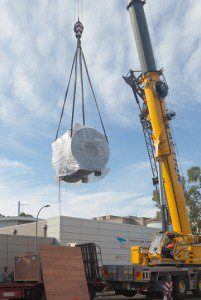
A world first large scale split core MRI magnet was craned into the Ingham Institute’s Research Bunker at 7am on Sunday.
The magnet represents the final piece of equipment of the institute’s flagship MRI-Linac cancer research project.
The MRI-Linac combines an MRI magnet with a Linear Accelerator to improve the accuracy and precision of radiotherapy treatment for cancer.
The revolutionary MRI-Linac technology is one of only three in the world and utilises a new world first technological concept and design.
In 2014, the Australian Cancer Research Foundation provided a grant of $2.5 million which contributed towards the purchase of the MRI-Linac technology.
Radiotherapy is a cancer treatment that uses a Linear Accelerator to produce X-rays that kill or damage tumours to stop them from growing.
However, by doing this, the radiation process may also damage normal tissue in the way of the radiation beam.
“Radiation treatments for cancer must take into account changes that can occur to the location and shape of tumours, which move as a result of breathing, swallowing and other normal body changes,’’ says associate professor Gary Liney, senior MRI physicist at the Ingham Institute.
[social_quote duplicate=”no” align=”default”]“This is where the strength of our MRI-Linac system comes into play, as it is the only system that will enable us to target the tumour with the radiation beam much more accurately in real time and have control over the radiation dose.’’[/social_quote]
Until now, the MRI and the Linac have worked separately.
With the MRI magnet’s arrival, cancer researchers and scientists at the Ingham Institute will be able to connect the two pieces of equipment together.
This enables a system that gives a real time view of tumours that stretches way beyond basic anatomy.
Its unique design will also give Ingham Institute scientists and researchers the ability to position the treatment or radiation beam in two different arrangements, also a world first.
“The Ingham Institute’s flagship MRI-Linac system is one of the most exciting initiatives I have worked on in my research career and it will improve the effectiveness of cancer treatment for patients in our community, Australia and around the world,” says professor Michael Barton, chief investigator and Ingham Institute research director.
The chief operating officer of the institute, professor Greg Kaplan says the Ingham Institute, here in South West Sydney, is rapidly becoming the world centre of development of this pioneering cancer treatment technology.
“The MRI-Linac will bring more talented scientists and doctors from around the world to this area to learn and advance the technology, delivering employment and business opportunities,” he said.
